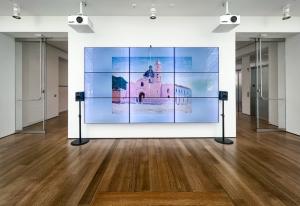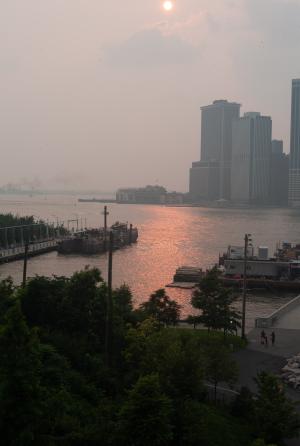Extreme weather
Feb 29, 2024 421 ppmMy Brooklyn apartment connects to the internet through NYC Mesh, a not-for-profit, volunteer-run community internet initiative. It's a beautiful thing. An antenna in my bedroom points at another node mounted on the roof of a building one block over which, in turn, is pointed at a larger hub miles away in Sunset Park, and so on.

As its signals travel through air rather than cable, the mesh depend on fair weather. It easily handles most conditions (I've used the mesh full-time for four years. It has been very reliable.) but extreme weather can cause my speed to drop or my home to go offline. A cold spell has frozen ice slush to the antennas, putting my internet out until it got warmer. The noise of torrential rain can degrade the connection across the river to Manhattan and grind to a halt home office workers' work video calls. When strong winds pushed the antenna out of alignment, the neighbors all lost connection. In time, a tree in my neighbor's backyard will grow into my antenna's line-of-sight and block the signal — at least in the warmer months when the tree has leaves.
I appreciate experiencing the internet somewhat synced to weather and natural cycles. The digital is never separate from the material world, naturally, but that is made easy to forget. Writing this reminds me of Solar Protocol, a network of solar-powered servers that routes internet traffic to whichever server receives the most sunshine at that moment. The project not only makes visible this connection but reimagines critical infrastructure as an emission-free public good.

In 2020 412 ppm I started working on a project that also alluded to the interconnected systems between technology, network, data, art, weather, and climate: an art installation for a glass-enclosed gallery on the top floor of the Harvard Art Museum in Cambridge, MA.
The project's core was a camera mounted to the glass roof of the museum, pointed at the sky. Using the camera feed and weather data, a custom software continuously selected works from the museum’s digitized collections by linking color, meteorological observations, and artwork metadata. The selected works were displayed on a screen in the gallery, overlaid on the sky photo that selected them.


In a sense, the weather curated the exhibition. Sometimes the links were literal, pairing blue skies with lush landscape paintings or abstract works in shades of blue. Other times, a pairing would suggest more complex associations.
Shown below is a partly cloudy sky at dusk, with a portrait of Adele Lehman, a philantrophist whose families made fortunes with copper mines during the dawn of electricity. If you allow it, a New England sunset made a connection to the digital networks's most basic element. Adele Lehman was married to Arthur Lehman, whose family bank in 2008 started a global financial crisis. Research suggests that financial crises, unsurprisingly, reduce countries' resilience to climate change.

Sympoiesis is a concept coined by Beth Dempster, and Dona Haraway, of "making together”, between living and non-living systems without spatial or temporal boundaries. I called my project Sympoietic System to acknowledge that climate and weather influence artmaking — and art in turn the weather. In the best cases, art may sway minds towards climate action, or help process climate grief. More often than not, art is creating its own toll through its wasteful practices. The fortunes that pay for name plaques on museum wings need art to get away with ever more extraction.
The exhibition was repeatedly delayed due to the COVID-19 pandemic. During that time, the sky above my home was tinted orange twice — in 2021 and 2023 — by the ashes of wildfire smoke carried to the city from faraway burns. Both times I wondered which artworks the system might have surfaced from the collection.
I like to imagine the system running long-term, a decade or longer. Individual images of the sky would become records of weather patterns and, eventually, of the climate and its accelerating warming. How many more New England snow storms would it capture and match with faint pencil drawings on white paper from the collection, how many more exhaustingly hot and humid Summer days paired with abstract paintings in red and blue?

